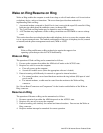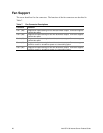14 Intel ISP1100 Internet Server Product Guide
IDE Support
The server board has two independent bus-mastering IDE interfaces that support:
1. ATAPI devices (such as CD-ROM drives).
2. ATA devices using the transfer modes listed in the Intel ISP1100 Internet Server Technical
Product Specification.
The BIOS supports logical block addressing (LBA) and extended cylinder head sector (ECHS)
translation modes. The drive reports the transfer rate and translation mode to the BIOS.
The server board supports PCMCIA ATA Type II flash card technology through its IDE interfaces.
No special driver is needed for a PCMCIA ATA Type II flash drive since most operating systems
see it as standard IDE drive.
Real-Time Clock, CMOS SRAM, and Battery
The real-time clock is compatible with DS1287 and MC146818 components. The clock provides a
time-of-day clock and a multi-century calendar with alarm features and century rollover. The real-
time clock supports 256 bytes of battery-backed CMOS SRAM in two banks that are reserved for
BIOS use.
A coin-cell Lithium battery powers the real-time clock and CMOS memory. When the computer is
not plugged into an AC power source, the battery has an estimated life of three years. When the
computer is plugged into an AC power source, the 3.3 V standby current from the power supply
extends the life of the battery. The clock is accurate to ±13 minutes/year at 25ºC with 3.3 V
standby applied.
The time, date, and CMOS values can be specified and the CMOS values can be returned to their
defaults in the BIOS Setup program.
NOTE
The recommended method for accessing the date in systems with Intel server
boards is indirectly from the real-time clock (RTC) via the BIOS. The BIOS
on the server board contains a century checking and maintenance feature that
checks the two least significant digits of the year stored in the RTC during
each BIOS request (INT 1Ah) to read the date. If the year is less than 80
(when 1980 is the first year supported by the PC), the BIOS updates the
century byte to 20 which enables operating systems and applications that use
the BIOS date/time services to reliably manipulate the year as a four-digit
value.
For more information on a proper date access in systems with Intel server
boards, please see: http://support.intel.com/support/year2000/


















